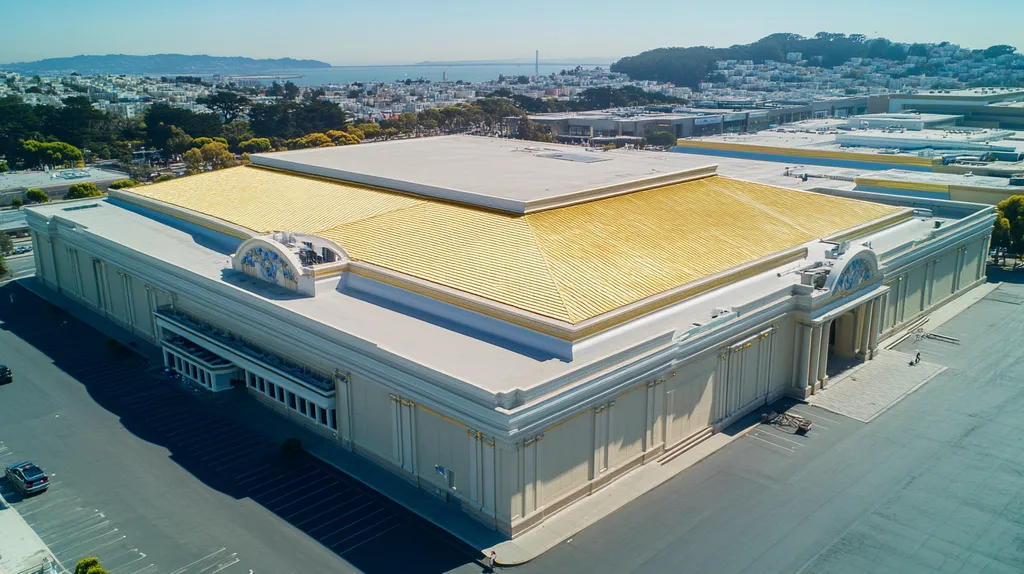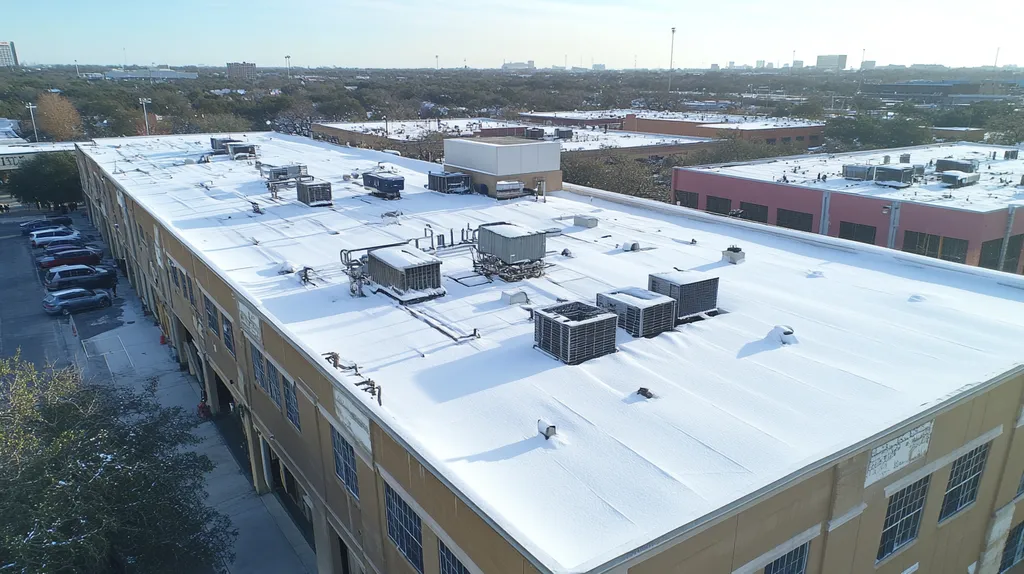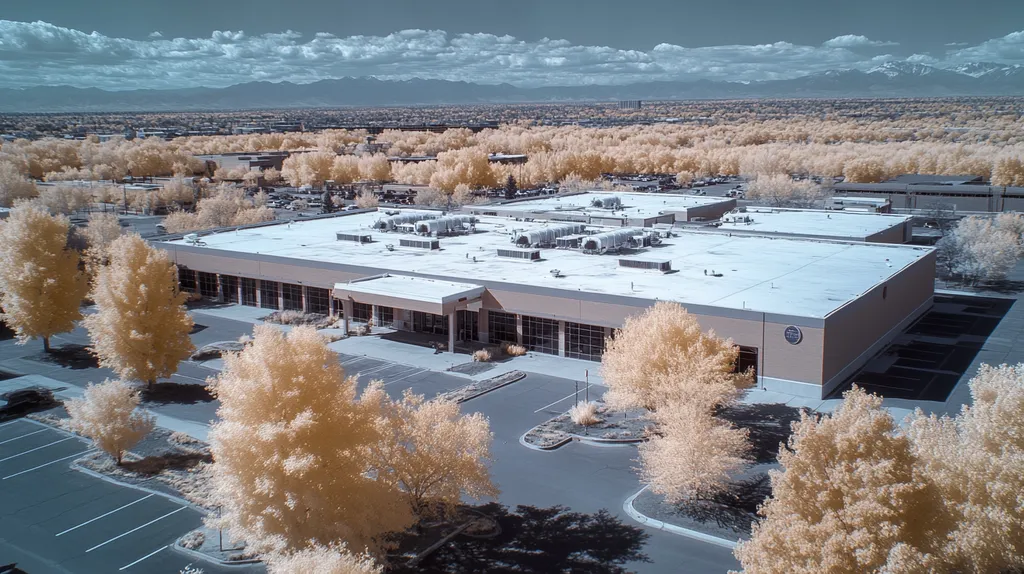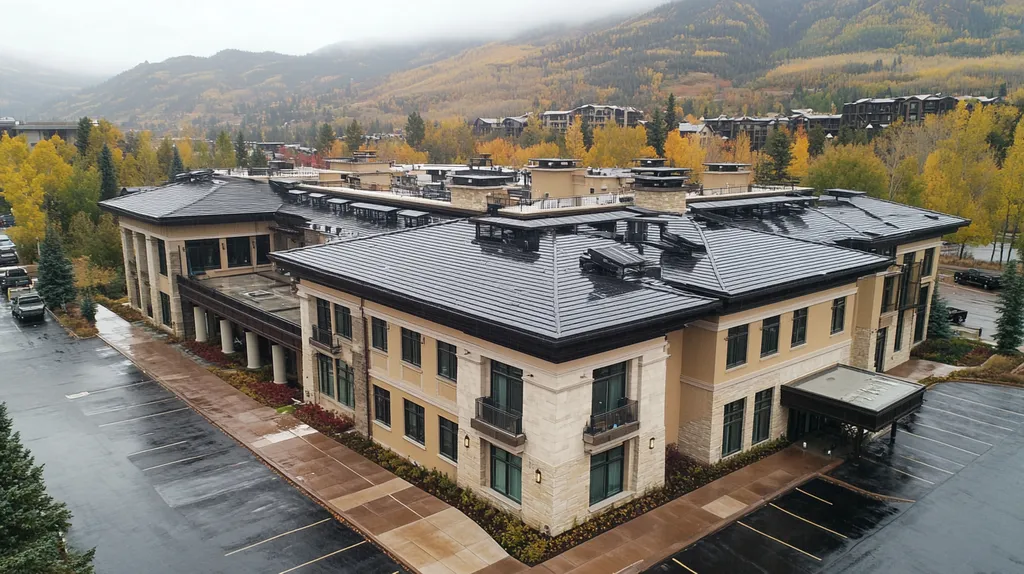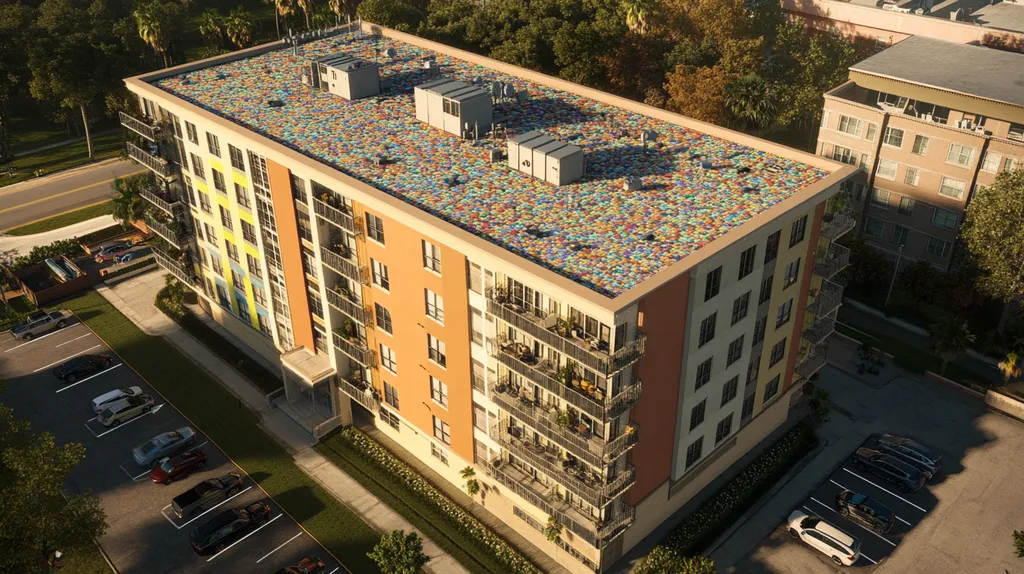Industrial facility managers face a critical challenge: nearly 40% of roof coating reapplications fail prematurely due to misconceptions about proper installation and material selection. These failures cost businesses millions annually in repairs, energy loss, and operational disruptions.
Understanding the realities of roof coating performance, from waterproofing capabilities to material compatibility, has become essential for protecting industrial assets and preventing costly mistakes.
This comprehensive analysis examines common myths, practical implications, and evidence-based solutions for successful roof coating projects, helping facility managers make informed decisions that maximize their roofing investments.
SECTION 1: COMMON MISCONCEPTIONS
Misunderstanding the properties and performance of roof coatings can have serious consequences for companies relying on industrial roofs. Incorrect assumptions can lead to devastating outcomes such as costly repairs and unexpected facility downtime. For instance, data indicates that premature coating failure can result in extensive water damage that impacts entire operations. This section clarifies key misconceptions about roof coatings, addressing their waterproof capabilities, the differences between material types, and necessary maintenance routines.
Coatings Are Completely Waterproof
It is a widespread notion that roof coatings provide a flawless waterproof barrier. While many coatings deliver impressive water resistance, they are not infallible against all conditions. Variables like surface preparation and environmental influences significantly impact their performance.
Pooling water and debris accumulation can undermine the coating’s effectiveness, allowing moisture to penetrate. Such situations can lead to leaks, structural degradation, and even mold proliferation. Consequently, property owners must closely monitor their coating’s condition.
Moreover, the water resistance of different coating materials varies. Familiarity with each type’s limitations is vital for making informed maintenance decisions.
Conducting regular inspections and adhering to a proactive maintenance strategy is essential for ensuring long-term coating effectiveness. This approach helps mitigate the risks associated with waterproofing failures.
Silicone vs. Acrylic: Which is Always Better?
The debate over silicone and acrylic coatings often becomes polarized, with many adhering to the belief that one is definitively superior. In truth, the choice between these materials hinges on specific roofing scenarios and environmental conditions.
Silicone coatings are renowned for their waterproofing ability and resistance to UV rays, making them suitable for roofs exposed to severe weather. However, their adhesion may falter on certain substrates, potentially resulting in delamination or blistering.
Conversely, acrylic coatings boast excellent adhesion and reflective properties. Yet, they can be susceptible to water damage if improperly applied. It is crucial to assess the unique characteristics of each coating type in relation to the roofing environment before making a selection.
For optimal results, property owners should consult with roofing experts to determine which coating type best aligns with their specific needs. This informed analysis fosters enhanced long-term performance and protection for the roofing system.
Coatings Require No Maintenance
A prevalent myth is that once applied, roof coatings necessitate no future maintenance. In reality, even the highest-quality coatings require regular upkeep to sustain their performance and longevity.
Debris, dirt, and biological growth can accumulate over time, degrading the coating’s effectiveness. Regular inspections are essential to catch early signs of wear or damage. This proactive practice can prevent significant repair costs later on.
Additionally, specific areas might require touch-ups when coatings have worn thin or been compromised. Facility managers should establish a maintenance schedule to routinely assess the roof coating’s condition.
Implementing a well-informed maintenance plan not only extends the life of the coating but also strengthens the overall integrity of the roof. Being attentive to maintenance needs safeguards the property’s investment.
SECTION 2: PRACTICAL IMPLICATIONS
Reapplying coatings to existing industrial roofs can be a game-changer for performance and durability. When done correctly, property owners can significantly extend their roofs’ lifespan, potentially adding a decade or more to their service life. Conversely, improper application can lead to extensive damage and costly repairs. Understanding the practical implications of this process is essential, particularly when navigating issues of material compatibility and energy efficiency.
Impact on Roof Lifespan and Performance
Applying roof coatings can dramatically enhance an existing industrial roof’s lifespan. Coatings serve as a protective barrier, shielding the roof from destructive UV rays, moisture, and extreme temperatures. Studies suggest that the right coating can add an impressive 10 to 15 years to a roof’s service life, as long as the underlying structure is sound.
However, applying coatings over a deteriorating roof without a comprehensive inspection can worsen existing problems. This oversight can result in significant roofing failures that require expensive repairs or even complete replacements. Prioritizing regular assessments of the roof’s condition before reapplication is crucial for optimal performance.
Additionally, the choice of coating influences overall performance. Various materials possess unique properties that affect factors like waterproofing and reflectivity. Property owners should educate themselves on these options to identify the solution best suited to their specific roofing needs.
Ultimately, understanding the implications of reapplying coatings can lead to savings in both time and money. Durable roofs not only enhance operational efficiency but also reduce the frequency of costly interventions.
Compatibility Issues with Existing Materials
Establishing compatibility between existing roofing materials and newly applied coatings is critical. Incompatible materials can result in adhesion failures and peeling over time. For example, applying an acrylic coating over an existing silicone roof can lead to bonding issues, undermining the new coating’s protective benefits.
Such failures expose the underlying roof to moisture ingress, potentially worsening structural integrity. Thoroughly assessing the compatibility of different roofing materials is essential to prevent these costly mistakes and ensure a more effective roofing system.
Moreover, chemical reactions between incompatible materials may accelerate wear and tear. Certain coatings contain solvents that can degrade older membranes, leading to further damage. Facility managers must engage with roofing professionals to identify suitable materials prior to application.
In summary, ensuring compatibility is vital for maintaining the overall integrity of the roofing system. Stakeholders should prioritize this consideration to avoid significant setbacks and expenses in their roofing projects.
Effects on Energy Efficiency and Temperature Control
Reapplying roof coatings can significantly enhance a building’s energy efficiency. Reflective coatings, designed to divert sunlight, can decrease heat absorption, resulting in cooling costs reductions of up to 20% in warmer climates.
However, property owners must carefully consider the type of coating used. Darker or non-reflective coatings tend to retain heat, which can raise energy expenses and diminish indoor comfort. Making an informed choice about coating types is crucial for achieving effective temperature regulation.
Energy-efficient roofs not only lower utilities bills but also contribute to broader sustainability efforts. Many businesses are shifting toward green building practices, and selecting the right roofing coatings can greatly boost a facility’s energy performance rating.
Ultimately, by thoughtfully assessing the effects of reapplying coatings, property owners can optimize energy efficiency in their industrial buildings. A well-executed application aligns financial savings with environmental responsibilities.
SECTION 3: COST OF MISINFORMATION
The stakes for properly applying coatings on industrial roofs are alarmingly high. Mistakes in application not only lead to immediate financial burden but also jeopardize the long-term integrity of roofing systems. Industry research shows that erroneous coating applications can escalate maintenance costs by as much as 30% over time. This section explores the serious financial implications, the ongoing burdens of maintenance, and the risks of structural damage arising from misinformed coating applications.
Financial Consequences of Incorrect Application
Misapplied roof coatings can trigger severe financial setbacks for facility owners. When a coating fails prematurely, it often results in the need for costly reapplications or, in worst-case scenarios, an entire roof replacement. Expenses related to labor, materials, and potential downtime can significantly strain an organization’s budget.
Some property owners may attempt to save money using cheaper application methods, only to later incur repair bills that far exceed their initial investments. Research suggests that missteps in coating applications may increase facility costs by over $2.50 per square foot. To effectively manage these financial risks, investing in proper coating application techniques is crucial.
Moreover, additional funds may be spent on troubleshooting and repairs. Each unplanned repair translates to lost productivity, directly impacting overall profitability. Understanding the full financial implications of incorrect applications is essential for maintaining a healthy budget.
Long-Term Maintenance and Repair Costs
Even if the initial coating application appears satisfactory, misinformation regarding ongoing maintenance can spiral into escalating costs. Many property owners neglect the fact that roof coatings require regular inspections and maintenance to ensure optimal performance. Skipping these essential tasks can cause minor issues to evolve into significant repair needs.
For instance, unchecked small cracks can allow moisture to infiltrate, jeopardizing the underlying structure and skyrocketing repair costs. Furthermore, neglecting maintenance may void existing warranties if instruction guidelines are not followed. Implementing a proactive maintenance plan is critical to avoid these pitfalls.
Additionally, coatings unsuitable for specific climate conditions may deteriorate faster, resulting in premature failures. Choosing the right materials and application methods plays a vital role in minimizing long-term expenses and emphasizes the need for reputable sources and expert advice in coating decisions.
Potential for Structural Damage and Litigation
Incorrectly applying roof coatings not only leads to financial issues but also poses severe risks to the structural integrity of the building. A compromised roof can result in serious damage, including leaks that threaten both the facility and its contents. The repercussions of such damage can ripple throughout an organization, leading to inventory loss, equipment damage, and exorbitant repair costs.
Additionally, building owners may encounter legal liabilities if structural failures result in injuries or damage to adjacent properties. Lawsuits stemming from negligence in roofing system upkeep can incur significant legal fees and settlements. Proper application and maintenance practices can help mitigate these risks.
In industrial environments, where safety regulations are stringent, demonstrating compliance with maintenance standards is essential. Failing to meet these requirements can lead to costly fines and legal complications. Thus, adopting accurate and informed coating application techniques is vital for maintaining safety and compliance in the long run.
SECTION 4: REALITY CHECK
Accurate knowledge about the real capabilities of roof coatings is crucial for effective industrial roofing management. Many property owners mistakenly believe that simply reapplying coatings will resolve all waterproofing issues. In reality, the effectiveness of these coatings can vary widely depending on their composition and the current state of the roof. Understanding these nuances equips decision-makers to make informed choices that protect their investments and enhance roof longevity.
Actual Waterproofing Capabilities of Coatings
Not every roof coating delivers the same level of waterproofing capability. Some coatings, particularly certain acrylic options, exist primarily to prolong the life of existing roof materials rather than act as a standalone waterproofing solution. For instance, while these coatings can provide reasonable water resistance, they may not hold up against pooling water or severe weather conditions. Research indicates that acrylic coatings can break down over time when exposed to ponding water, leading to premature failures (source: American WeatherStar).
Therefore, property owners must carefully set performance expectations for their coatings to prevent unexpected failures. Many mistakenly assume that a coating creates a waterproof barrier; recognition of its limitations is crucial to avoid costly leaks and repairs.
Surface preparation is equally important for achieving optimal waterproofing results. Ensuring clean surfaces is vital for proper adhesion of the coating material. Without thorough cleaning and priming, coatings may peel or flake off, negating their water-resistant properties.
Ultimately, understanding these various factors will guide property owners in selecting the right products and application methods for their roofs, enhancing performance and longevity.
Differences in High-Solids vs. Solvent-Based Coatings
Grasping the differences between high-solids and solvent-based coatings is essential for facility managers considering roof recoating. High-solids coatings, which contain a greater proportion of active ingredients, provide richer coverage and superior durability when compared to solvent-based options, which typically have a lower solids content.
This difference significantly influences coat performance, especially concerning longevity and resilience to environmental factors. High-solids coatings often age more slowly and retain their protective qualities longer, whereas solvent-based coatings may require more frequent applications.
Moreover, high-solids coatings can boost energy efficiency by reflecting UV rays, which can lower cooling costs significantly in warm climates. In contrast, solvent-based coatings may evaporate quickly, releasing volatile organic compounds (VOCs) that can compromise indoor air quality.
By understanding these distinctions, facility managers can make better selections that align with their specific roofing needs, thus preventing costly mistakes stemming from inadequate performance or improper application.
Repair and Recoating Challenges and Solutions
Addressing potential challenges effectively is critical when planning for recoating. A prevalent issue is the presence of existing damages, including cracks or punctures that must be repaired prior to applying new coatings. Overlooking these issues can allow moisture to breach the roof, irrespective of the new coating’s application quality.
Compatibility between the existing roof surface and the new coating also poses significant challenges. A thorough evaluation is necessary to determine if the current materials can correctly bond with the new coating. This may involve using specific adhesives or primers to ensure strong adhesion.
Weather conditions during application must also be optimal; coatings should ideally be applied in dry and temperate conditions. Rain or extreme temperatures can adversely affect the curing process, resulting in subpar coating performance.
Implementing a comprehensive assessment before recoating can significantly mitigate these challenges. By ensuring proper surface preparation, material compatibility, and ideal application conditions, property owners can protect their roofs against leaks and future failures.
SECTION 5: EVIDENCE-BASED ALTERNATIVES
Informed decision-making is essential for industrial property owners and facility managers seeking to optimize their roofing systems. The choice of coating can significantly impact a roof’s durability and performance. Research indicates that selecting the wrong coating can lead to premature failures, costing businesses thousands in unnecessary repairs and operational downtime. This section emphasizes the critical importance of selecting appropriate materials, ensuring precision in installation, and monitoring roof conditions regularly.
Selecting the Right Coating for Your Roof Type
Different industrial roof types require specific coatings tailored to their unique characteristics. For example, single-ply membranes may need acrylic coatings, while metal roofs could benefit from polyurethane solutions. Utilizing an incompatible coating can result in inadequate adhesion and underperformance due to varying environmental stressors.
Polyurethane coatings excel in durability and are particularly suitable for high foot traffic areas, while acrylic coatings offer excellent reflectivity for warmer climates. Each option has its advantages and requires careful consideration of the roof’s existing conditions and potential stressors before making a selection.
Inspecting for existing damage—such as blisters or cracks—is vital in choosing the right product. This assessment not only guides material selection but also enhances the roof’s overall performance and lifespan, safeguarding the property’s investment.
Lastly, consulting an expert ensures that the chosen coating meets industry standards, contributing to greater long-term cost efficiency through improved weather resistance and energy performance.
Importance of Proper Installation and Inspection
Proper installation of roof coatings is crucial for maximizing their effectiveness. Even high-quality coatings can fail if not applied according to manufacturer specifications. Engaging trained roofing contractors helps ensure that all application processes adhere to best practices, which can significantly influence waterproofing and insulation outcomes.
Regular inspections during the installation phase are essential for identifying potential issues related to environmental conditions, such as moisture levels that affect adhesion. Facilities managers must prioritize these checks to ensure that installation teams follow recommended protocols to optimize coating systems.
Moreover, incorrect installations can not only reduce a coating’s effectiveness but may also void manufacturer warranties. Therefore, selecting contractors with verifiable credentials and consistent standards is imperative.
Investing in quality installation not only enhances a facility’s long-term value but also diminishes future maintenance costs. Regular follow-ups and a rigorous quality assurance program can significantly influence the longevity of roofing systems.
Benefits of Regular Monitoring and Early Leak Detection
Routine maintenance is vital for the longevity of industrial roofs. Regular monitoring allows facility managers to identify minor issues before they escalate into costly repairs. The financial impact of fixing a small leak pales in comparison to dealing with major structural failures later on.
Utilizing technology, such as thermal imaging, allows for the detection of leaks that may not be visible to the naked eye. Early leak detection prevents revenue losses caused by downtime and reduces the financial burden of extensive repair needs. Facilities managers should integrate regular inspections into their comprehensive maintenance plans.
Maintaining a log of inspection results promotes effective forecasting for future maintenance. This proactive approach enables managers to allocate resources efficiently, ensuring that budgets are prepared to tackle emerging issues.
Lastly, regular monitoring helps maintain compliance with safety regulations, fostering a secure work environment. By prioritizing early leak detection, organizations can enhance operational efficiency and protect their investments across their facilities.
SECTION 6: TEST AND VERIFY
In industrial roofing, the failure to properly test and verify coating compatibility can have dire financial implications, leading to costly leaks and extensive system failures. Research indicates that nearly 60% of roofing problems arise from incorrect coating applications. This underscores the necessity for thorough assessments before reapplying coatings. In this section, essential testing procedures, advanced monitoring systems for leak detection, and the critical importance of verifying credentials for both manufacturers and contractors will be outlined.
Conducting Compatibility Tests for Coatings
Before the reapplication of coatings, conducting compatibility tests is not just advisable; it is essential. Different coatings possess distinct chemical compositions, which may interact negatively when combined. A straightforward adhesion test can ascertain whether the new coating will bond effectively to the existing roof surface.
Following manufacturers’ guidelines for conducting these tests can significantly mitigate risks associated with adhesion failures. The industry convention often recommends applying a small sample to evaluate how the new coating reacts with the existing material over time, helping to identify potential issues early on. This proactive method can save time and resources in the long run.
Moreover, selecting coatings compatible with existing layers ensures longevity and optimal performance. Overlooking compatibility can lead to serious issues, such as bubbling or peeling, indicative of a failed application. Thorough testing thus serves to protect the investment made in the roofing system and maximize its potential.
Monitoring Systems for Leak Detection
Implementing robust monitoring systems is critical for safeguarding the integrity of an industrial roof. While regular inspections are valuable, they are often not sufficient to catch early signs of leaks. Advanced monitoring systems provide real-time data, alerting facility managers to potential issues before they escalate.
For example, moisture detection sensors can be installed within the roofing structure to identify trapped moisture early, aiding in quick responses to water infiltration issues. This proactive approach can substantially minimize repair costs associated with leaks.
Additionally, using technologies such as infrared thermography can reveal water accumulation beneath the roof surface. This non-invasive technique allows for the identification of leaks without direct access, preserving the integrity of vulnerable areas.
Keeping updated with the latest monitoring practices equips facility managers with crucial information needed for informed maintenance and repair decisions, thus protecting against costly downtime.
Verifying Manufacturer and Contractor Credentials
Confirming that both manufacturers and contractors hold the appropriate credentials is a cornerstone of a successful roof coating project. The roofing industry offers many options, but not all providers possess the necessary qualifications. Validating certifications and licenses is critical to avoiding the use of inferior materials or unreliable services.
Noteworthy industry certifications, such as those from the National Roofing Contractors Association (NRCA) or the Roofing Industry Alliance for Progress, showcase a commitment to quality and professional standards. Always request proof of these certifications prior to starting any projects.
Furthermore, seeking references and reviews from previous clients provides insight into a contractor’s reliability and experience with similar projects. A contractor’s proven history can greatly influence the successful outcome of a roof coating application.
In conclusion, a rigorous vetting process for both materials and professionals significantly increases the chances of a successful roof coating project, ultimately extending the longevity and performance of the roofing system.
The Bottom Line
With 40% of industrial roof coating reapplications failing prematurely, facility managers must prioritize evidence-based decision-making to protect their investments.
Understanding coating limitations, ensuring material compatibility, and implementing proper testing protocols can mean the difference between a 15-year extended roof life and catastrophic system failure.
Regular monitoring, coupled with appropriate material selection and professional installation, remains crucial for maintaining waterproof integrity and preventing costly structural damage.
As industrial roofing technology continues to evolve, staying informed about coating capabilities, installation best practices, and maintenance requirements will become increasingly vital for facility managers seeking to optimize their roofing systems’ performance and longevity.
FREQUENTLY ASKED QUESTIONS
Q. Are commercial roof coatings completely waterproof?
A. Many coatings provide significant water resistance; however, they are not foolproof. Performance depends on conditions such as surface preparation and environmental factors. Accumulated debris can compromise effectiveness, leading to potential leaks.
Q. How do I extend the lifespan of my industrial roof?
A. Reapplying coatings correctly can add 10 to 15 years to your roof’s lifespan. However, ensure the underlying structure is sound and compatible with the chosen material to avoid exacerbating existing issues.
Q. What are the financial consequences of incorrect coating applications?
A. Misapplied coatings often lead to costly reapplications and repairs, which can strain budgets. Research indicates that errors can increase facility costs by over $2.50 per square foot, emphasizing the importance of proper application techniques.
Q. Can reapplying coatings resolve all waterproofing issues?
A. Not necessarily. The effectiveness of coatings varies widely. Issues like pooling water might still occur, depending on the coating composition and the existing roof’s condition. Expectations should reflect their limitations.
Q. Why is selecting the right coating crucial for my commercial roof?
A. Different roof types require coatings that align with their unique characteristics to avoid underperformance. Using incompatible materials can lead to poor adhesion and subsequent roofing failures, ultimately impacting financial investments.
Q. How can I identify potential leaks early in my industrial roof?
A. Implementing monitoring systems, such as moisture sensors and thermal imaging, allows for early detection of water infiltration. Regular inspections and maintenance help catch minor issues before they escalate into significant repairs.
Q. What should I do before reapplying coatings?
A. Conduct comprehensive assessments to verify compatibility with existing materials. Address any damage before application and ensure optimal weather conditions for the coating process to enhance performance and longevity.

